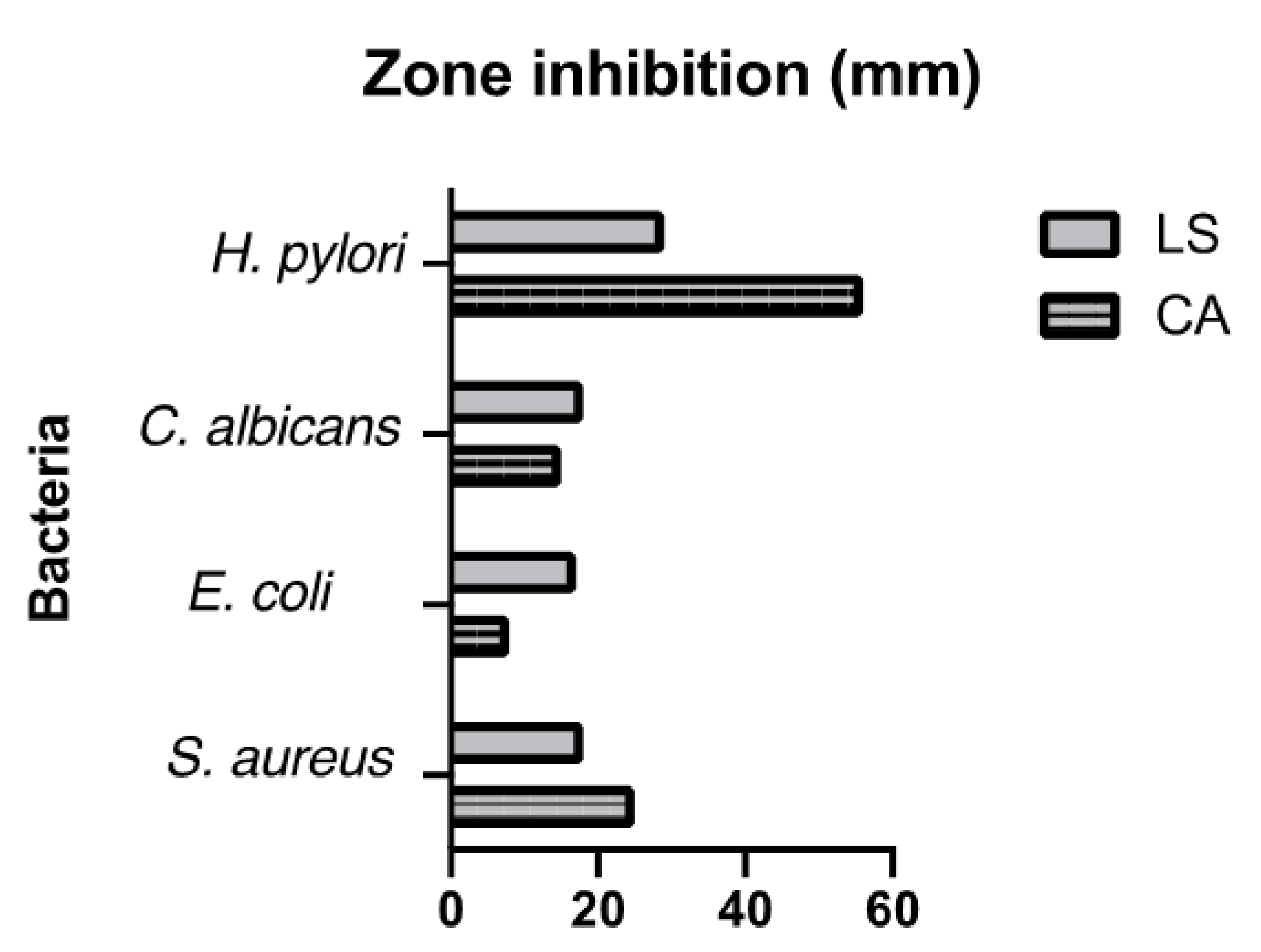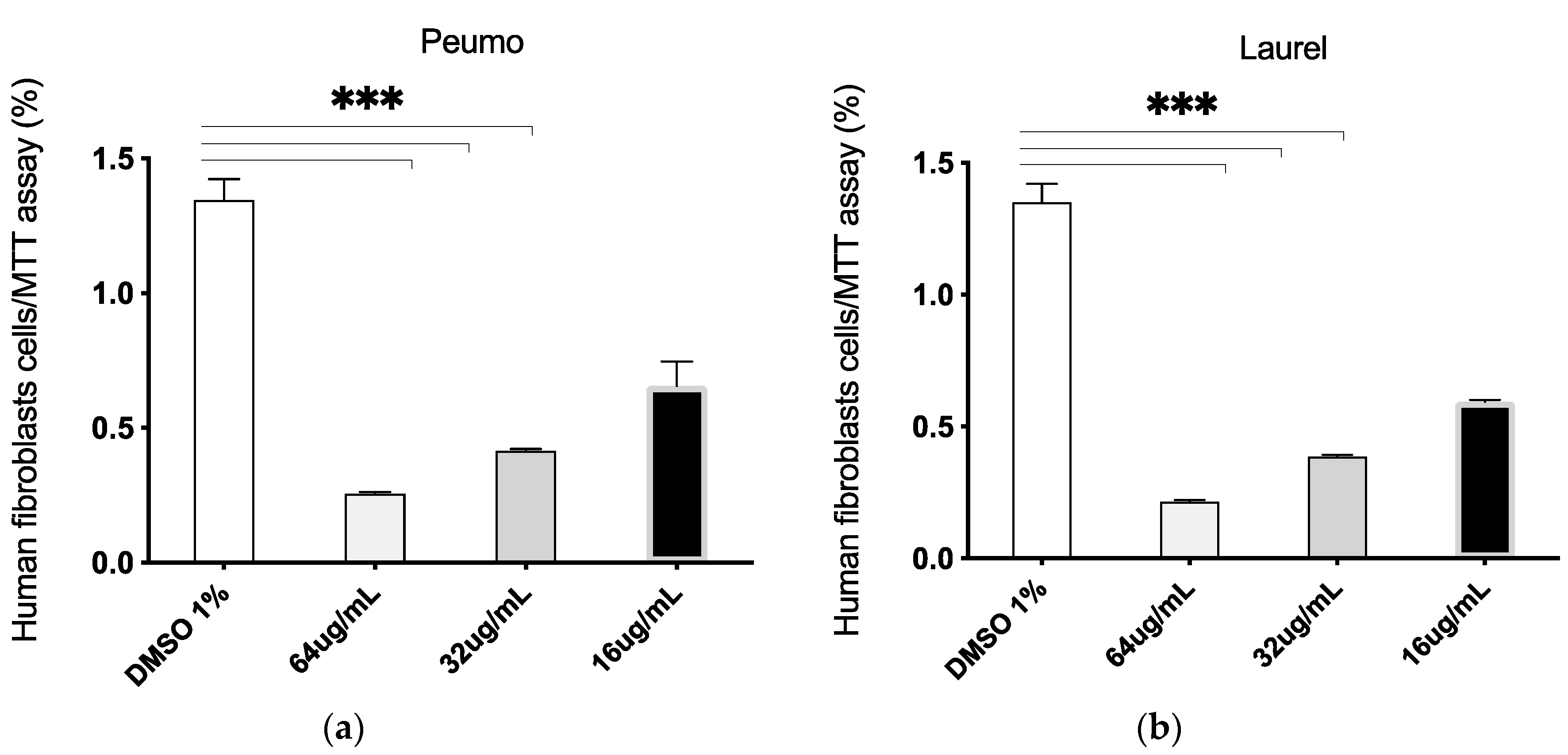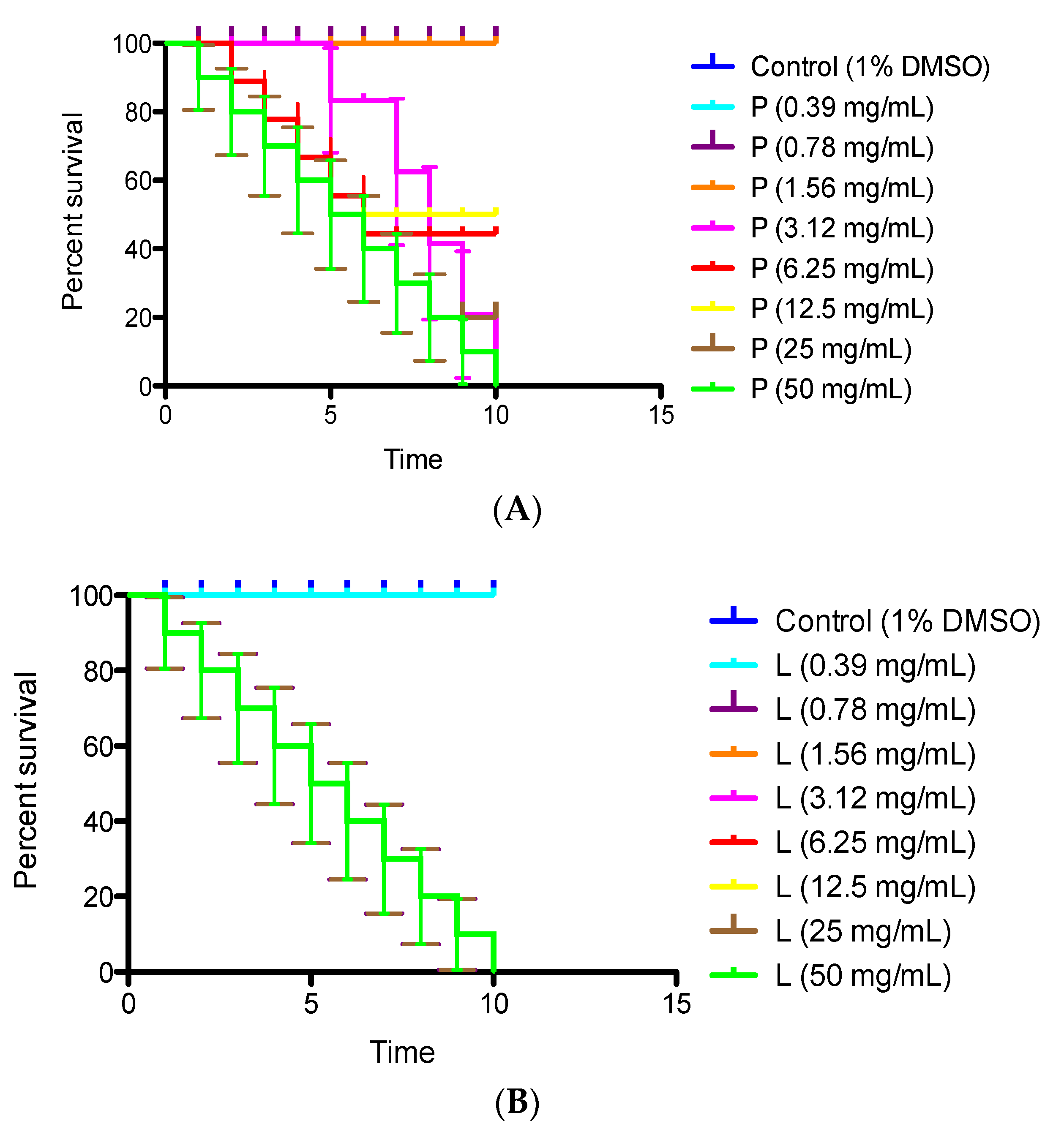The Chemical Compositions of Essential Oils Derived from Cryptocarya alba and Laurelia sempervirens Possess Antioxidant, Antibacterial and Antitumoral Activity Potential
Abstract
:1. Introduction
2. Results
2.1. Composition
2.2. Antioxidant Capacity
2.3. Antimicrobial Activity
2.4. Cytotoxicity Activity
2.5. Toxicity
3. Discussion
4. Materials and Methods
4.1. Composition
4.2. Collection Identification and Extraction
4.3. Antioxidant Capacity
4.3.1. Chemical Materials
4.3.2. Total Polyphenol Content (TPC) Estimation
4.3.3. FRAP Assay
4.3.4. DPPH Radical Scavenging Activity Assay
4.3.5. ABTS Radical-Scavenging Activity Assay
4.4. Antibacterial Activity
4.4.1. Chemical Materials and Antibiotics
4.4.2. Microbial Strains
4.4.3. Agar Disk Diffusion Assay
4.4.4. Microplate Assay
4.5. Cytotoxicity
4.5.1. Cell Lines Culture
4.5.2. Chemical Materials
4.5.3. Crystal Violet Proliferation Assay
4.5.4. MTT Proliferation Assay
4.5.5. Statistical Analysis
4.6. Toxicity
4.6.1. Chemical Materials
4.6.2. Maintenance of Caenorhabditis Elegans Culture
4.6.3. Test Preparation
5. Conclusions
Supplementary Materials
Author Contributions
Funding
Acknowledgments
Conflicts of Interest
Abbreviations
References
- Mølgaard, P.; Holler, J.G.; Asar, B.; Liberna, I.; Rosenbæk, L.B.; Jebjerg, C.P.; Jørgensen, L.; Lauritzen, J.; Guzman, A.; Adsersen, A.; et al. Antimicrobial evaluation of Huilliche plant medicine used to treat wounds. J. Ethnopharmacol. 2011, 138, 219–227. [Google Scholar] [CrossRef] [PubMed]
- Bray, F.; Ferlay, J.; Soerjomataram, I.; Siegel, R.L.; Torre, L.A.; Jemal, A. Global cancer statistics 2018: GLOBOCAN estimates of incidence and mortality worldwide for 36 cancers in 185 countries. CA Cancer J. Clin. 2018, 68, 394–424. [Google Scholar] [CrossRef] [PubMed] [Green Version]
- Lesgards, J.-F.; Baldovini, N.; Vidal, N.; Pietri, S. Anticancer Activities of Essential Oils Constituents and Synergy with Conventional Therapies: A Review. Phytother. Res. 2014, 28, 1423–1446. [Google Scholar] [CrossRef] [PubMed]
- Blowman, K.; Magalhães, M.; Lemos, M.F.L.; Cabral, C.; Pires, I.M. Anticancer Properties of Essential Oils and Other Natural Products. Evid.-Based Complement. Altern. Med. 2018, 2018, 1–12. [Google Scholar] [CrossRef]
- Xiong, R.; Jiang, J.; Chen, Y. Cytotoxic lignans from Cryptocarya impressinervia. Nat. Prod. Res. 2019, 1–5. [Google Scholar] [CrossRef]
- Suzuki, Y.; Saito, Y.; Goto, M.; Newman, D.J.; O’Keefe, B.R.; Lee, K.-H.; Nakagawa-Goto, K. (-)-Neocaryachine, an Antiproliferative Pavine Alkaloid from Cryptocarya laevigata, Induces DNA Double-Strand Breaks. J. Nat. Prod. 2017, 80, 220–224. [Google Scholar] [CrossRef] [Green Version]
- Al-Kalaldeh, J.Z.; Abu-Dahab, R.; Afifi, F.U. Volatile oil composition and antiproliferative activity of Laurus nobilis, Origanum syriacum, Origanum vulgare, and Salvia triloba against human breast adenocarcinoma cells. Nutr. Res. 2010, 30, 271–278. [Google Scholar] [CrossRef]
- Bittner, M.L.; Arbert, C.; E Casanueva, M.; Aguilera, M.A.; Hernandez, V.; Becerra, J. Fungistatic Activity Of Essential Oils Extracted from Peumus boldus Mol., Laureliopsis philippiana (Looser) Schodde and Laurelia sempervirens (Ruiz & Pav.) Tul. (Chilean Monimiaceae). Chil. J. Agric. Res. 2009, 69, 30–37. [Google Scholar] [CrossRef] [Green Version]
- Lorca, M.A.; Canales, C.L.; Valenzuela, C.G.; Concha, E.B.; Chait, A.B.; Navarrete, C.E.P.; Berner, C.M.B. Efectos antimicrobianos de extractos de plantas chilenas de las familias Lauraceae y Atherospermataceae. Rev. Cuba. de Plantas Med. 2012, 17, 73–83. [Google Scholar]
- Bravo, J.; Carbonell, V.; Sepúlveda, B.; Delporte, C.; Valdovinos, C.; Martín-Hernández, R.; Higes, M. Antifungal activity of the essential oil obtained from Cryptocarya alba against infection in honey bees by Nosema ceranae. J. Invertebr. Pathol. 2017, 149, 141–147. [Google Scholar] [CrossRef]
- Zapata, N.; Smagghe, G. Repellency and toxicity of essential oils from the leaves and bark of Laurelia sempervirens and Drimys winteri against Tribolium castaneum. Ind. Crop. Prod. 2010, 32, 405–410. [Google Scholar] [CrossRef]
- Montes, M.; Valenzuela, L.; Wilkomirsky, T.; Sanguinetti, A.; Von Baer, D. [Chemical composition of the essential oil of Cryptocarya alba (Mol.) Looser (Lauraceae) in Chile]. Ann. Pharm. Fr. 1988, 46, 41–47. [Google Scholar] [PubMed]
- García, L.T.; Leal, A.F.; Moreno, É.M.; Stashenko, E.E.; Arteaga, H.J. Differential anti-proliferative effect on K562 leukemia cells of Lippia alba (Verbenaceae) essential oils produced under diverse growing, collection and extraction conditions. Ind. Crop. Prod. 2017, 96, 140–148. [Google Scholar] [CrossRef]
- Jiao, J.; Fu, Y.-J.; Zu, Y.; Luo, M.; Wang, W.; Zhang, L.; Li, J. Enzyme-assisted microwave hydro-distillation essential oil from Fructus forsythia, chemical constituents, and its antimicrobial and antioxidant activities. Food Chem. 2012, 134, 235–243. [Google Scholar] [CrossRef]
- Damasceno, C.S.B.; Higaki, N.T.F.; Dias, J.D.F.G.; Miguel, M.D.; Miguel, O.G. Chemical Composition and Biological Activities of Essential Oils in the Family Lauraceae: A Systematic Review of the Literature. Planta Med. 2019, 85, 1054–1072. [Google Scholar] [CrossRef] [PubMed] [Green Version]
- Sharifi-Rad, J.; Sureda, A.; Tenore, G.C.; Daglia, M.; Sharifi-Rad, M.; Valussi, M.; Tundis, R.; Sharifi-Rad, M.; Loizzo, M.R.; Ademiluyi, A.O.; et al. Biological Activities of Essential Oils: From Plant Chemoecology to Traditional Healing Systems. Molecules 2017, 22, 70. [Google Scholar] [CrossRef]
- Amorati, R.; Foti., M.C.; Valgimigli, L. Antioxidant Activity of Essential Oils. J. Agric. Food Chem. 2013, 61, 10835–10847. [Google Scholar] [CrossRef]
- Larrazabal-Fuentes, M.; Palma, J.; Paredes, A.; Mercado, A.; Neira, I.; Lizama, C.; Sepulveda, B.; Bravo, J. Chemical composition, antioxidant capacity, toxicity and antibacterial activity of the essential oils from Acantholippia deserticola (Phil.) Moldenke (Rica rica) and Artemisia copa Phil. (Copa copa) extracted by microwave-assisted hydrodistillation. Ind. Crop. Prod. 2019, 142, 111830. [Google Scholar] [CrossRef]
- Miguel, M.G. Antioxidant activity of medicinal and aromatic plants. A review. Flavour Fragr. J. 2010, 25, 291–312. [Google Scholar] [CrossRef]
- Memariani, Z.; Sharifzadeh, M.; Bozorgi, M.; Hajimahmoodi, M.; Farzaei, M.H.; Gholami, M.; Siavoshi, F.; Saniee, P. Protective effect of essential oil of Pistacia atlantica Desf. on peptic ulcer: Role of α-pinene. J. Tradit. Chin. Med. 2017, 37, 57–63. [Google Scholar] [CrossRef]
- Edris, A.E. Pharmaceutical and therapeutic Potentials of essential oils and their individual volatile constituents: A review. Phytother. Res. 2007, 21, 308–323. [Google Scholar] [CrossRef] [PubMed]
- Raut, J.S.; Karuppayil, S.M. A status review on the medicinal properties of essential oils. Ind. Crop. Prod. 2014, 62, 250–264. [Google Scholar] [CrossRef]
- Bergonzelli, G.; Donnicola, D.; Porta, N.; E Corthésy-Theulaz, I. Essential oils as components of a diet-based approach to management of Helicobacter infection. Antimicrob. Agents Chemother. 2003, 47, 3240–3246. [Google Scholar] [CrossRef] [PubMed] [Green Version]
- Ultee, A.; Bennik, M.H.J.; Moezelaar, R. The Phenolic Hydroxyl Group of Carvacrol Is Essential for Action against the Food-Borne Pathogen Bacillus cereus. Appl. Environ. Microbiol. 2002, 68, 1561–1568. [Google Scholar] [CrossRef] [PubMed] [Green Version]
- Burt, S. Essential oils: Their antibacterial properties and potential applications in foods—A review. Int. J. Food Microbiol. 2004, 94, 223–253. [Google Scholar] [CrossRef]
- Ohno, T.; Kita, M.; Yamaoka, Y.; Imamura, S.; Yamamoto, T.; Mitsufuji, S.; Kodama, T.; Kashima, K.; Imanishi, J. Antimicrobial Activity of Essential Oils against Helicobacter pylori. Helicobacter 2003, 8, 207–215. [Google Scholar] [CrossRef]
- Benites, J.; Moiteiro, C.; Miguel, G.; Rojo, L.E.; López, J.; Venâncio, F.; Ramalho, L.; Feio, S.; Dandlen, S.; Casanova, H.; et al. Composition And Biological Activity Of The Essential Oil Of Peruvian Lantana Camara. J. Chil. Chem. Soc. 2009, 54, 379–384. [Google Scholar] [CrossRef]
- Zapata, N.; Lognay, G.; Smagghe, G. Bioactivity of essential oils from leaves and bark of Laurelia sempervirens and Drimys winteri against Acyrthosiphon pisum. Pest. Manag. Sci. 2010, 66, 1324–1331. [Google Scholar] [CrossRef]
- Feoktistova, M.; Geserick, P.; Leverkus, M. Crystal Violet Assay for Determining Viability of Cultured Cells. Cold Spring Harb. Protoc. 2016, 2016, 087379. [Google Scholar] [CrossRef]
- Bayala, B.; Bassole, I.H.; Scifo, R.; Gnoula, C.; Morel, L.; Lobaccaro, J.-M.A.; Simporé, J. Anticancer activity of essential oils and their chemical components—A review. Am. J. Cancer Res. 2014, 4, 591–607. [Google Scholar]
- Carnesecchi, S.; Bras-Gonçalves, R.; Bradaia, A.; Zeisel, M.; Gossé, F.; Poupon, M.-F.; Raul, F. Geraniol, a component of plant essential oils, modulates DNA synthesis and potentiates 5-fluorouracil efficacy on human colon tumor xenografts. Cancer Lett. 2004, 215, 53–59. [Google Scholar] [CrossRef] [PubMed]
- Yu, X.; Lin, H.; Wang, Y.; Lv, W.; Zhang, S.; Qian, Y.; Deng, X.; Feng, N.; Yu, H.; Qian, B.-Y. D-limonene exhibits antitumor activity by inducing autophagy and apoptosis in lung cancer. OncoTargets Ther. 2018, 11, 1833–1847. [Google Scholar] [CrossRef] [PubMed] [Green Version]
- Jia, S.-S.; Xi, G.-P.; Zhang, M.; Chen, Y.-B.; Lei, B.; Dong, X.-S.; Yang, Y.-M. Induction of apoptosis by D-limonene is mediated by inactivation of Akt in LS174T human colon cancer cells. Oncol. Rep. 2012, 29, 349–354. [Google Scholar] [CrossRef] [PubMed] [Green Version]
- Manuele, M.G.; Arcos, M.L.B.; Davicino, R.; Ferraro, G.; Cremaschi, G.; Anesini, C. Limonene Exerts Antiproliferative Effects and Increases Nitric Oxide Levels on a Lymphoma Cell Line by Dual Mechanism of the ERK Pathway: Relationship with Oxidative Stress. Cancer Investig. 2009, 28, 135–145. [Google Scholar] [CrossRef] [PubMed]
- Chaudhary, S.; Siddiqui, M.; Athar, M.; Alam, M.S. d-Limonene modulates inflammation, oxidative stress and Ras-ERK pathway to inhibit murine skin tumorigenesis. Hum. Exp. Toxicol. 2012, 31, 798–811. [Google Scholar] [CrossRef] [PubMed]
- Mo, H.; Elson, C.E. Studies of the Isoprenoid-Mediated Inhibition of Mevalonate Synthesis Applied to Cancer Chemotherapy and Chemoprevention. Exp. Biol. Med. 2004, 229, 567–585. [Google Scholar] [CrossRef] [PubMed]
- A Ariazi, E.; Satomi, Y.; Ellis, M.J.; Haag, J.D.; Shi, W.; A Sattler, C.; Gould, M.N. Activation of the transforming growth factor beta signaling pathway and induction of cytostasis and apoptosis in mammary carcinomas treated with the anticancer agent perillyl alcohol. Cancer Res. 1999, 59, 1917–1928. [Google Scholar]
- Yu, J.Q.; Liao, Z.X.; Cai, X.Q.; Lei, J.C.; Zou, G.L. Composition, antimicrobial activity and cytotoxicity of essential oils from Aristolochia mollissima. Environ. Toxicol. Pharmacol. 2007, 23, 162–167. [Google Scholar] [CrossRef]
- Forno, A.H.D.; Câmara, D.; Parise, B.; Rodrigues, C.F.; Soares, J.J.; Wagner, R.; Ribeiro, S.R.; Folmer, V.; Puntel, R.L.; Haas, S.E.; et al. Antioxidant and lipid lowering effects of dried fruits oil extract of Pterodon emarginatusin Caenorhabditis elegans. Arab. J. Chem. 2019, 12, 4131–4141. [Google Scholar] [CrossRef] [Green Version]
- Satyal, P.; Dosoky, N.S.; Kincer, B.L.; Setzer, W.N. Chemical Compositions and Biological Activities of Amomum subulatum Essential Oils from Nepal. Nat. Prod. Commun. 2012, 7, 1233–1236. [Google Scholar] [CrossRef] [Green Version]
- Lei, J.; Leser, M.; Enan, E. Nematicidal activity of two monoterpenoids and SER-2 tyramine receptor of Caenorhabditis elegans. Biochem. Pharmacol. 2010, 79, 1062–1071. [Google Scholar] [CrossRef] [PubMed]
- Khanavi, M.; Laghaei, P.; Isman, M.B. Essential oil composition of three native Persian plants and their inhibitory effects in the cabbage looper, Trichoplusia ni. J. Asia-Pacific Èntomol. 2017, 20, 1234–1240. [Google Scholar] [CrossRef]
- Sparkman, O.D. Identification of essential oil components by gas chromatography/quadrupole mass spectroscopy Robert P. Adams. J. Am. Soc. Mass Spectrom. 2005, 16, 1902–1903. [Google Scholar] [CrossRef] [Green Version]
- Akter, K.; Barnes, E.C.; Loa-Kum-Cheung, W.L.; Yin, P.; Kichu, M.; Brophy, J.J.; Barrow, R.A.; Imchen, I.; Vemulpad, S.R.; Jamie, J. Antimicrobial and antioxidant activity and chemical characterisation of Erythrina stricta Roxb. (Fabaceae). J. Ethnopharmacol. 2016, 185, 171–181. [Google Scholar] [CrossRef] [PubMed]
- Mathew, M.; Subramanian, S. In Vitro Screening for Anti-Cholinesterase and Antioxidant Activity of Methanolic Extracts of Ayurvedic Medicinal Plants Used for Cognitive Disorders. PLoS ONE 2014, 9, e86804. [Google Scholar] [CrossRef] [PubMed]
- Horvathova, E.; Navarova, J.; Galova, E.; Sevcovicova, A.; Chodakova, L.; Snahnicanova, Z.; Melusova, M.; Kozics, K.; Slamenova, D. Assessment of Antioxidative, Chelating, and DNA-Protective Effects of Selected Essential Oil Components (Eugenol, Carvacrol, Thymol, Borneol, Eucalyptol) of Plants and IntactRosmarinus officinalisOil. J. Agric. Food Chem. 2014, 62, 6632–6639. [Google Scholar] [CrossRef] [PubMed]
- Petrelli, R.; Orsomando, G.; Sorci, L.; Maggi, F.; Ranjbarian, F.; Nya, P.C.B.; Petrelli, D.; Vitali, L.A.; Lupidi, G.; Quassinti, L.; et al. Biological Activities of the Essential Oil from Erigeron floribundus. Molecules 2016, 21, 1065. [Google Scholar] [CrossRef]
- Jones, R. NCCLS guidelines: Revised performance standards for antimicrobial disk susceptibility tests. Antimicrob. Newsl. 1984, 1, 64–65. [Google Scholar] [CrossRef]
- Morcillo, N.; Di Giulio, B.; Testani, B.; Pontino, M.; Chirico, C.; Dolmann, A. A microplate indicator-based method for determining the susceptibility of multidrug-resistant Mycobacterium tuberculosis to antimicrobial agents. Int. J. Tuberc. Lung Dis. 2004, 8, 253–259. [Google Scholar]
- Brenner, S. The genetics of caenorhabditis elegans. Genetics 1974, 77, 71–94. [Google Scholar]
- Skantar, A.M.; Agama, K.; Meyer, S.L.F.; Carta, L.K.; Vinyard, B.T. Effects of Geldanamycin on Hatching and Juvenile Motility in Caenorhabditis elegans and Heterodera glycines. J. Chem. Ecol. 2005, 31, 2481–2491. [Google Scholar] [CrossRef] [PubMed] [Green Version]






| Fraction Number | Retention Time (min) | CAS | KI Cal | KI Lit | [M+] | Fragment | % | Name |
|---|---|---|---|---|---|---|---|---|
| (A) C. Alba Essential Oil | ||||||||
| 1 | 14.5 | 99-83-2 | - | 1007 | 136 | 99 (100) 91 (38) 77 (33) | 0.71 | d-phellandrene |
| 2 | 14.8 | 7785-70-8 | 1025 | 939 | 136 | 93 (100) 92 (41) 79 (19) | 3.88 | 1R-α-pinene |
| 3 | 15.7 | 79-92-5 | 1041 | 953 | 136 | 93 (100) 121 (66) 41 (38) | 0.19 | Camphene |
| 4 | 17.0 | 555-10-2 | 1081 | 1035 | 136 | 93 (100) 43 (38) 121 (23) | 14.84 | β-phellandrene |
| 5 | 17.3 | 18172-67-3 | 1012 | 981 | 136 | 93 (100) 41 (69) 69 (43) | 4.18 | l-β-pinene |
| 6 | 19.5 | 586-62-9 | 1085 | 1088 | 136 | 93 (100) 121 (98) 136 (72) | 0.92 | Terpinolene |
| 7 | 19.9 | 527-84-4 | 1067 | 1014 | 136 | 93 (100) 135 (75) 121 (46) | 3.99 | o-cimol |
| 8 | 20.1 | 5989-54-8 | 1050 | 1031 | 136 | 68 (100) 93 (57) 39 (36) | 3.41 | Limonene |
| 9 | 20.3 | 470-82-6 | 1013 | 1030 | 154 | 139 (100) 154 (85) 27 (28) | 21.63 | Eucalyptol |
| 10 | 21.7 | 99-85-4 | 1035 | 1057 | 136 | 93 (100) 91 (35) 136 (33) | 2.67 | γ-terpinene |
| 11 | 24.3 | 54410-94-5 | 1053 | 1116 | 170 | 68 (100) 57 (43) 41 (39) | 1.34 | 3 methyl 3 butenyl |
| 12 | 26.6 | 562-74-3 | 1079 | 1177 | 154 | 71 (100) 111 (53) 43 (45) | 1.72 | 4-terpineol |
| 13 | 27.2 | 98-55-8 | 1009 | 1189 | 154 | 59 (100) 93 (53) 43 (45) | 24.96 | α- terpineol |
| 14 | 33.3 | 17699-05-7 | 1580 | 1434 | 204 | 93 (100) 119 (86) 41 (51) | 2.88 | α-bergamolene |
| 15 | 34.8 | 339154-91-5 | 1575 | 1430 | 204 | 121 (100) 93 (69) 41 (63) | 0.99 | γ-elemene |
| 16 | 35.3 | 483-77-2 | 1515 | 1523 | 202 | 132 (100) 159 (98) 131 (51) | 1.36 | calamenene |
| 17 | 38.1 | 473-15-4 | 1733 | 1645 | 223 | 207 (100) 125 (19) 153 (15) | 1.49 | β-eudesmol |
| (B) L. Sempervirens Essential Oil | ||||||||
| 1 | 12.0 | 138-86-3 | - | 1036 | 136 | 93 (100) 68 (67) 136 (63) | 5.3 | Limonene |
| 2 | 12.8 | 13877-91-3 | 1000 | 1023 | 136 | 93 (100) 91 (57) 41 (54) | 1.3 | O-cimene |
| 3 | 20.3 | 120-58-1 | 1000 | - | 162 | 162 (100) 104 (31) 78 (13) | 91.9 | Isozafrol |
| 4 | 24.7 | 489-39-4 | 1148 | - | 204 | 41 (100) 161 (92) 91 (86) | 0.5 | Aromadendrene |
| 5 | 25.2 | 23986-74-5 | 1500 | 1499 | 204 | 161 (100) 105 (79) 41 (62) | 0.7 | Germacrene D |
| 6 | 25.6 | 339154-91-5 | - | 1433 | 204 | 121 (100) 93 (69) 41 (63) | 0.3 | γ-elemene |
| Essential Oils | Total Phenols a | FRAP b | IC50 DPPH c | IC50 ABTS c |
|---|---|---|---|---|
| L. sempervirens | 63.7 ± 10.7 | 229.8 ± 11.1 * | 417.8 ± 5.8 +++ | 401.2 ± 8.7 +++ |
| C. alba | 163.6 ± 10.7 ** | 166.8 ± 27.9 | 492.7 ± 11.1 +++ | 203.0 ± 12.8 **,+++ |
| Trolox | -- | -- | 11.7 ± 2.1 | 35.6 ± 1.5 |
| EO or Its Purified Component | MIC (μg/mL) H. pylori | MIC (μg/mL) S. aureus | MIC (μg/mL) E. coli | MIC (μg/mL) C. albicans |
|---|---|---|---|---|
| CA_EO | 30 | 19 | 36 | 31 |
| α-terpineol | 27 | 32 | 16 | 16 |
| β-phellandrene | 30 | 32 | 32 | 32 |
| Eucalyptol | 30 | 32 | 32 | 32 |
| LS_EO | 64 | 64 | 64 | 64 |
| Limonene | 32 | 32 | 64 | 64 |
Sample Availability: Not available. |
Publisher’s Note: MDPI stays neutral with regard to jurisdictional claims in published maps and institutional affiliations. |
© 2020 by the authors. Licensee MDPI, Basel, Switzerland. This article is an open access article distributed under the terms and conditions of the Creative Commons Attribution (CC BY) license (http://creativecommons.org/licenses/by/4.0/).
Share and Cite
Touma, J.; Navarro, M.; Sepúlveda, B.; Pavon, A.; Corsini, G.; Fernández, K.; Quezada, C.; Torres, A.; Larrazabal-Fuentes, M.J.; Paredes, A.; et al. The Chemical Compositions of Essential Oils Derived from Cryptocarya alba and Laurelia sempervirens Possess Antioxidant, Antibacterial and Antitumoral Activity Potential. Molecules 2020, 25, 5600. https://doi.org/10.3390/molecules25235600
Touma J, Navarro M, Sepúlveda B, Pavon A, Corsini G, Fernández K, Quezada C, Torres A, Larrazabal-Fuentes MJ, Paredes A, et al. The Chemical Compositions of Essential Oils Derived from Cryptocarya alba and Laurelia sempervirens Possess Antioxidant, Antibacterial and Antitumoral Activity Potential. Molecules. 2020; 25(23):5600. https://doi.org/10.3390/molecules25235600
Chicago/Turabian StyleTouma, Jorge, Myriam Navarro, Betsabet Sepúlveda, Alequis Pavon, Gino Corsini, Katia Fernández, Claudia Quezada, Angelo Torres, María José Larrazabal-Fuentes, Adrian Paredes, and et al. 2020. "The Chemical Compositions of Essential Oils Derived from Cryptocarya alba and Laurelia sempervirens Possess Antioxidant, Antibacterial and Antitumoral Activity Potential" Molecules 25, no. 23: 5600. https://doi.org/10.3390/molecules25235600
APA StyleTouma, J., Navarro, M., Sepúlveda, B., Pavon, A., Corsini, G., Fernández, K., Quezada, C., Torres, A., Larrazabal-Fuentes, M. J., Paredes, A., Neira, I., Ferrando, M., Bruna, F., Venegas, A., & Bravo, J. (2020). The Chemical Compositions of Essential Oils Derived from Cryptocarya alba and Laurelia sempervirens Possess Antioxidant, Antibacterial and Antitumoral Activity Potential. Molecules, 25(23), 5600. https://doi.org/10.3390/molecules25235600







